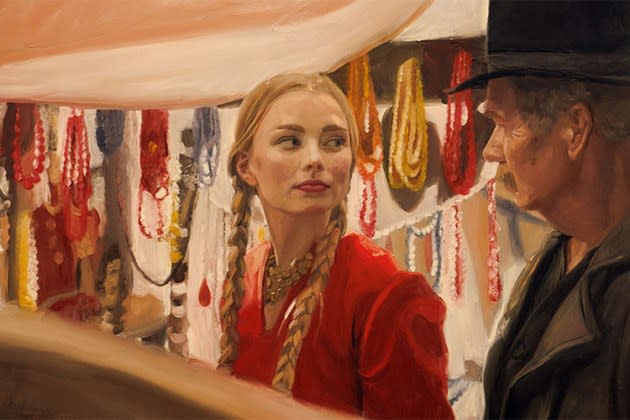‘The Peasants’ Review: ‘Loving Vincent’ Directors Return With a Sumptuous Animated Portrait of a Polish Village
- Oops!Something went wrong.Please try again later.
- Oops!Something went wrong.Please try again later.
- Oops!Something went wrong.Please try again later.

It would have been natural for directors DK Welchman and Hugh Welchman to follow up their highly acclaimed, arthouse smash hit Loving Vincent, about Vincent Van Gogh, with another film exactly in the same vein: Pining for Picasso, Mooning Over Monet, Rhapsodizing About Rembrandt — the possibilities seem aimless. But this talented husband-and-wife filmmaking team has taken their distinctive style of painterly cinema in an even more ambitious direction with their new effort, which received its world premiere at the Toronto International Film Festival. Adapted from Polish author Wladyslaw Reymont’s Nobel Prize-winning novel, released in four parts from 1904 to 1909, The Peasants is a ravishingly beautiful visual triumph.
The folklore-style tale, set in a 19th-century rural Polish village, revolves around star-crossed lovers. Jamila (Kamila Urzedowska, stunning in animated form) is a young woman whose striking blonde beauty has made her both the subject of intense gossip among the villagers and the object of the attention of nearly every male in the vicinity. Occupying herself with creating paper cutout artwork and nursing injured animals back to health, she lives a life that becomes tumultuous when she enters into a torrid affair with older married man Antek (Robert Gulaczyk, who played Van Gogh in Loving Vincent), the headstrong son of the village’s most prosperous landowner, the recently widowed Maciej (Miroslaw Baka).
More from The Hollywood Reporter
Antek deeply resents his tyrannical father, who refuses to share any of his wealth with him or his two siblings until after his death. Their combative relationship becomes even more troubled when Maciej enters into a marriage with Jamila arranged by her mother. Jamila and Antek continue their assignations at greater and greater risk, leading to a dramatic chain of events that culminates with the villagers violently turning on the adulterous bride.
The melodramatic storyline and broad characterizations are the least compelling element of the Polish-language film adaptation, which can feel overlong with its nearly two-hour running time. (The length is understandable, however, considering that Reymont’s novel — divided, like the film, into parts linked to the four seasons — runs 1,000 pages or so.)
Rather, it’s the sheer luminosity of the images on display that keeps you thoroughly enthralled. The filmmakers’ technique involves shooting the entire film in live-action form, with real actors and sometimes real sets, and then painting tens of thousands of frames in rotoscoping fashion to produce the feeling of oil paintings come to dynamic life.
The result is near hallucinatory in its effect, as if walking through an art museum filled with masterpieces that have lives of their own. The actors’ performances inevitably take on a larger-than-life aura — if this filmmaking style had been prevalent during the Golden Age of Hollywood, the top stars wouldn’t have been demanding the best make-up artists, lighting directors and cameramen, but rather the studios’ most talented oil painters.
Not surprisingly, the sequences benefiting the most from the approach are the most painterly to begin with, from landscape and nature shots spanning the various seasons to a lively wedding bursting with folk dancing and music, the latter enlivened with contemporary rhythms by Polish composer/rapper Lukasz “L.U.C.” Rostkowski. The film also pays homage to art history, a la Loving Vincent, with recreations of celebrated paintings by several notable Polish artists.
The Peasants is definitely not an animated movie for younger viewers; it contains adult themes, brutal violence and full-frontal nudity, the last no less erotic for being rendered in painterly form.
Best of The Hollywood Reporter
Kim Cattrall and Five Actors Who Made Surprising Returns to a Role
10 Times Hollywood Predicted the Scary (or Not So Scary) Future of AI
21 Actors Who Committed to Method Acting at Some Point in Their Career

